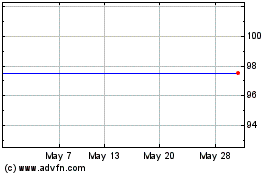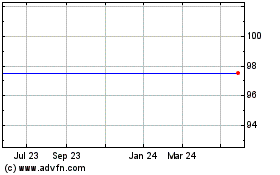Co-O Mine New Shaft To Raise Production
10 April 2008 - 5:02PM
UK Regulatory
Co-O Mine New Shaft To Raise Production
10 April 2008
MEDUSA MINING LIMITED
(AIM: MML)
NEW SHAFT TO RAISE PRODUCTION TO 100,000 OUNCES/YEAR FROM CO-O MINE
Medusa Mining Limited ("Medusa" or the "Company"), the Australian
based company operating and developing gold mines in the Philippines,
announces that it is undertaking preparations for a second phase of
expansion. This will target production of 100,000 ounces of gold per
year from its expanded Co-O Mine resource of 713,000 ounces at 10.9
g/t gold.
To achieve this production, the Company has elected to sink a new
vertical shaft to an initial depth of approximately 420 metres, with
the capacity for it to be deepened to 600 metres in the future. The
new shaft will be named the Hill View Shaft. The current timetable
is for work to start on the shaft in July 2008 with a target date for
ore haulage in the first quarter of 2010.
This Phase 2 expansion will not interfere with the current scheduled
production of 60,000 annualised ounces following the Phase 1
expansion.
Please see the link at the end of this announcement for Figure 1,
which shows a 3D diagram detailing the approximate position of the
new shaft at the Co-O Mine.
For further information, please contact:
Medusa Mining Limited +61 8 9367 0601
Geoffrey Davis, Managing Director
Roy Daniel, Finance Director
Fairfax I.S. PLC +44 (0)20 7598 5368
Nominated Adviser / Joint Broker
Ewan Leggat
Mirabaud Securities Limited +44 (0)20 7321 2508
Joint Broker
Peter Krens
Bankside Consultants +44 (0)20 7367 8888
Michael Padley / Louise Davis
Background
The current resource size, combined with on-going drill intersections
indicating the deposit is still open along strike in both directions
as well as at depth, justifies an expanded production profile to
approximately 100,000 ounces per year.
The initial shaft target depth, as shown on Figure 1 (please see the
link at the end of this announcement), is approximately 420 metres or
100 metres below (at the 2850 metre level) the "in-progress" Agsao
Shaft (which will bottom at the 2950 metre level). The shaft will
have the capacity to be further deepened to 600 metres. The new deep
shaft will have a double drum winder with the capacity to hoist up to
700 tonnes per day of ore, which, when combined with the Agsao Shaft,
Beta, 3W and 10W shafts, will lift hoisting capacity from the mine to
approximately 1,000 tonnes of ore per day. At the current reserve
grade of 11.1 g/t gold, this equates to approximately 100,000 ounces
of gold production per year.
If the resource increases continue with the on-going drilling, then
further expansion phases may be considered at a later date.
The Company also canvassed, as an alternative, a decline but decided
to opt for the deep shaft after taking into account the following
factors:
1.Climatic factors
(a)The mine is situated in a high rainfall tropical environment
requiring high capacity pumping equipment for routine pumping and
emergency high flow periods.
(b)A decline would likely significantly increase the required pumping
capacity.
2.Geological and structural factors and ground water
(a)A recent broad scale tectonic study indicates the Co-O deposit
sits in a regional scale north-trending fault corridor, as evidenced
by numerous north-trending faults cross-cutting the veins in the
mine. Some of these act as water conduits;
(b)The tectonics study also indicates the Co-O vein system is
controlled by a very prominent set of deep seated east-trending
structures that host the veins. These also sometimes act as water
conduits;
(c)The general rock conditions encountered in the mine and in
drilling to date can be described as reasonable to good, although low
grade propylitic alteration is generally pervasive;
(d)The general premise that large openings (as in declines with a
minimum size of 4 metres by 4 metres) present more difficult ground
support conditions is exemplified by the large diameter drives used
for the intial access to the mine in the late 1980s. These original
openings continue to require significant ground support maintenance
as well as exemplifying the ground support problems that would have
been encountered during their construction. Large openings also tend
to act as more efficient traps for underground water collection than
small openings.
3.Workforce expertise factors
(a)The Company currently has a work force experienced in rail and
shaft mining.
(b)A decline would require a new workforce to be engaged.
4.Equipment, spare parts inventories and maintenance
(a)For a shaft, the Company would require only to expand its current
equipment, spare parts inventories and maintenance requirements with
which its work force and suppliers are already familiar;
(b)A decline would require the purchase of specific heavy duty mining
equipment, a large spare parts inventory, construction of new,
specifically equipped workshops and the hiring of qualified
maintenance crews;
(c)There are currently world-wide shortages of specialised heavy
equipment for declines with long lead times on orders, problems in
co-ordinating the arrival of a complete equipment fleet which will
likely severely affect fleet functionality on setting up a new
operation, as well as the availability of spare parts, in particular
rubber tyres;
(d)On-going equipment maintenance costs for a decline are estimated
at approximately US$400,000 per month and 30 to 40% of the cost of
the decline.
5.Energy inputs
(a)The shaft will be able to be operated with power from the
"under-construction" power line to the mine using hydro-generated
electricity;
(b)A decline would use diesel equipment with resultant escalating
costs as fuel prices continue to increase.
6.Capital costs and time for completion for ore haulage
(a)Whilst capital costs are being finalised, preliminary estimates
indicate that the capital costs of the shaft will be significantly
less than the decline;
(b)Both options on preliminary estimates would be completed and
hauling ore in a similar timeframe.
7.Mobile surface equipment and mill upgrade
(a)Both options will require the same increase in surface mobile
equipment, such as front end loaders and haulage trucks;
(b)Both options will require the progressive addition of new tankage
capacity at the plant to match the crushing and grinding capacity of
approximately 1000 tonnes per day.
8.Tailings dam
(a)Both options require the construction of a new tailings dam
facility by approximately the end of 2009. The Company has recently
finalised land purchases for this facility.
Based on the above, the Company has chosen the Hill View Shaft option
as the most suitable for its future needs.
Information in this report relating to Exploration Results is based
on information compiled by Mr Geoff Davis, who is a member of The
Australian Institute of Geoscientists. Mr Davis is the Managing
Director of Medusa Mining Limited and has sufficient experience which
is relevant to the style of mineralisation and type of deposits under
consideration and to the activity which he is undertaking to qualify
as a Competent Person as defined in the 2004 Edition of the
"Australian Code for Reporting of Exploration Results, Mineral
Resources and Ore Reserves". Mr Davis consents to the inclusion in
the report of the matters based on his information in the form and
context in which it appears.
- ---END OF MESSAGE---
http://hugin.info/138050/R/1207807/249082.pdf
Medusa (LSE:MML)
Historical Stock Chart
From Jun 2024 to Jul 2024

Medusa (LSE:MML)
Historical Stock Chart
From Jul 2023 to Jul 2024

Real-Time news about Medusa Mining (London Stock Exchange): 0 recent articles
More Medusa Mining Ltd News Articles